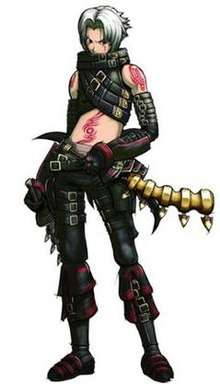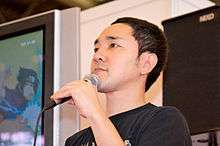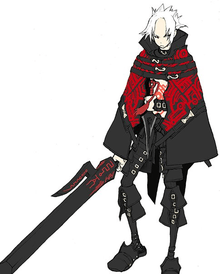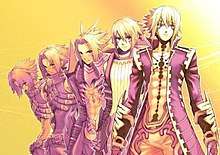Haseo
Haseo (Japanese: ハセヲ), real name Ryou Misaki (Japanese: 三崎亮, Hepburn: Misaki Ryō), is a fictional character in the .hack franchise first introduced as the main character from the video game trilogy .hack//G.U. in 2006 by CyberConnect2. He is also the lead character from the anime television series .hack//Roots by Bee Train. Haseo is a player character from the fictional massively multiplayer online role-playing game "The World" and is controlled by the player. In .hack//G.U. Haseo is introduced as a player killer of player killers, earning the nickname "The Terror of Death" (死の恐怖, Shi no Kyōfu). Searching for the mysterious player killer Tri-Edge who sent his friend Shino in a coma in real life, Haseo comes into contact with the guild G.U.. They seek to use his PC to destroy AIDA, a computer anomaly responsible for leaving players in coma. Haseo's appearances in .hack//Roots depicts his early days in The World as a member of the Twilight Brigade guild led by Ovan, where he first meets Shino. He has also appeared in other printed adaptations from the .hack//G.U. games.
| Haseo | |
|---|---|
| .hack character | |
 Haseo as seen in his initial form in .hack//G.U. Vol. 1: Rebirth | |
| First game | .hack//G.U. Vol. 1: Rebirth (2006) |
| Created by | Hiroshi Matsuyama, Tatsuya Hamasaki |
| Designed by | Seiichiro Hosokawa, Yoshiyuki Sadamoto |
| Voiced by | Japanese Takahiro Sakurai English Yuri Lowenthal (.hack//G.U.) Andrew Francis (.hack//Roots) |
Haseo was created by CyberConnect2 CEO Hiroshi Matsuyama who aimed Haseo to be a different protagonist from previous .hack lead Kite. Since Kite was created to be the player's avatar in the original story, Haseo was meant to be more individual when it comes to his characterization, giving him darker traits. He was designed by Seiichiro Hosokawa, a new artist who joined CyberConnect2 in 2006. Takahiro Sakurai voices Haseo in Japanese. In the English version, Haseo is voiced by Yuri Lowenthal in the games and Andrew Francis in the anime.
Video game publications have given both positive and negative response to Haseo's character, with most criticism being aimed towards his rude personality. On the other hand, his development across the games and the improvement to his PC resulted in positive responses. Both Sakurai and Lowenthal were also praised for their role in the games. Haseo's characterization was also the subject of mixed responses in other media.
Creation and design

Haseo was designed to have a darker design than previous .hack characters to reflect the more mature storyline from the .hack//G.U. games.[1] Hiroshi Matsuyama considered Kite as a relatable character and thus wanted the next game to feature a different take of lead character for .hack//G.U..[2] In contrast to the kind Kite from .hack, Haseo's antisocial personality was meant to reflect shonen manga leads who would display iconic elements such as "rage, despair, conflict, courage, and victory".[3] His characterization meant to be more appealing based on how player is distanced from the new protagonist. While the third title ended Haseo's story, Matsuyama had mixed thoughts about it.[4] In some scenes from the game's beginning, Haseo was designed to give a scary look.[5] While .hack and .hack//Sign were conceived as two ongoing an connected projects, Matsuyama wanted to do the same with .hack//GU. However, Matsuyama wanted both .hack//G.U. and .hack//Roots to feature the same lead character, Haseo. However, he found it might come across as challenging to make the writing make both stay true to the original writing. The director also designed the character's hair to make it come across as an immature high school student. When doing this, Matsuyama conceived the idea of the Haseo's Xth form from the third game of the series that would affect not only his PC's body armor but also his hair to come across as a subtle change in his growth. Still finding difficulties in writing this, Matsuyama received help through writer Tatsuya Hamasaki who wrote the part of the series' script.[6] Haseo and his friend Ovan were designed by Seiichiro Hosokawa. They both were Hosokawa's first creations upon becoming a professional especially during his rookie days at CyberConnect2.[7]
As one of the themes of the series is "Grow Up", Haseo gradually matures across .hack//G.U..[8] In regards to his visual appearance, originally CyberConnect2 aimed to give his initial form more clothing, including a cape but ended with a design that revealed his skin.[9] While CyberConnect2 designed the character, the staff asked artist Yoshiyuki Sadamoto for input in regards if it was an appropriate look. As a result, some asthetics from Haseo's design featured in the games' original trailers were removed from the finished product.[10] In the Japanese versions of the games, Haseo has been solely voiced by Takahiro Sakurai. In the English version Yuri Lowenthal was first cast to voice Haseo in the games. However, since the dub of .hack//Roots was produced separately from that of .hack//G.U., Haseo was instead voiced by Andrew Francis for the anime series.[8] Lowenthal came to like Haseo based on his character arc to the point of cosplaying as him.[11]

For the CGI movie, Matsuyama wanted him to be given more realisitc expressions, resulting in alterations to his design.[12] Matsuyama wanted the film to deeply focus on Haseo and Atoli's relationship.[13] Additionally, with the film Matsuyama wanted to give Haseo another design as he felt retelling the story with the same abilities the character possessed would not attract returning fans. This was called "B-st Form" which occurs when Haseo loses his control when believing Atoli is killed.[14] In trailers of the film, Haseo's B-st form was kept in secret to the point he joked they might be different characters.[13] Matsuyama gave multiple directions to Sakurai for the Trilogy film, including how he should act in a scene like he was throwing up due to his large amount of yells.[13]
For the remasterization version of the trilogy, CyberConnect2 aims to make newcomers "meet Haseo for the first time".[15] In the making of the series' remaster, Matsuyama felt unable to confirm the actual news from publications if Haseo was the character featured in previews often laughing about it.[16] Matsuyama wanted to use the remaster as an epilogue to Haseo's story and to further promote it, the team designed a new form for combat.[3] CyberConnect2 wrote mulitple joke videos, finding Sakurai suitable to make act in them despite how Sakurai found it messy.[17] Sakurai expressed and exhaustion when talking about his work, considering he had to work as Haseo in different sorts of media. Motivated by Matsuyama, Sakurai exclaimed he had fun with his work, specially as he had to work properly to make it appealing. This was most noted in the CGI film.[18] One of the parody videos involves Haseo getting married with Ovan for which Itsuki Hoshi designed an alternate take of Haseo wearing a wedding dress. Most of the female staff members from CyberConnect2 argued who would wear the wedding dress in the making of it.[19]
Appearances
.hack//G.U. games

Haseo is introduced in the .hack//G.U. games as a famous player from "The World" who several player killers and is known as "The Terror of Death".[20] He is in a search for the legendary player killer Tri-Edge, who left his friend Shino in a coma in real life after killing her character.[21] He is guided by his former comrade, Ovan, to fight the AI Azure Kite under the assumption he is Tri-Edge, though he is completely reset after being defeated.[22] As he recovers, Haseo is mistaken for a new player by Gaspard and Silabus, who ask him to become their guildmaster. Haseo also agrees to join the guild G.U. led by Yata, a System Administrator in The World R:2, to discover the reason behind a sudden increase in AIDA activity and Tri-Edge using it to leave players in coma.[23] Haseo gains an "Avatar", Skeith, The Terror of Death, hidden within his PC, that has the ability to destroy AIDA.[24] Although initially cold and antisocial, Haseo comes to appreciate the friendships he makes across the trilogy. He also starts developing feelings for Atoli, a fellow player who encourages him to appreciate his time in The World, but is not until late part of the trilogy that Haseo understands his feelings.[25]
Using Skeith, Haseo defeats Azure Kite but none of Tri-Edge's victims recover. He then continues working with G.U. to eliminate the AIDA that has been infecting other players and learn more about Tri-Edge.[26] During the .hack//G.U. games Haseo becomes a friendly person and learns to depend on others, coming to terms with his dark past.[27] He eventually learns that the real Tri-Edge is Ovan.[28] Ovan has been planning on Haseo to develop his Avatar abilities by fighting against multiple enemies so that he would gain enough power to completely destroy Ovan's own Avatar. In their final fight, an overwhelmed Ovan uses his Avatar's abilities to delete AIDA across the network, awakening most of the comatose players.[29] Following this a being called Cubia awakens and starts devouring The World; its destruction would result in the death of all the players who have yet to recover.[30] Since the Avatars are Cubia's counterpart, Haseo and G.U. join forces to destroy their enemy using Skeith. Following Cubia's defeat, Shino's awakens much to Haseo's relief.
In HD release of the series, a new chapter involves Haseo working with Pi to find a way to awake Ovan, whose PC was found the World.
G.U. related series and adaptations
Haseo has also appeared in the anime television series .hack//Roots, where he is depicted as a new player who is invited to join Ovan's Twilight Brigade and search for a legendary item known as the Key of Twilight.[31] While dealing with a rival guild, TaN, Ovan disappears, and the other members abandon the guild, leaving only Shino and Haseo.[32] When Shino ends up in a coma after being attacked by Tri-Edge, Haseo becomes depressed and searches for revenge.[33] In his quest for power, Haseo meets the AI of The World's creator, Harald Hoerwick, who highly upgrades Haseo's PC.[34] In the following months, he becomes known as "The Terror of Death" after defeating one hundred player killers, and meets Ovan again, who directs him to Azure Kite.[35] This leads to the events of the .hack//G.U. games as a weakened Haseo continues his journey.[36] An original video animation titled .hack//Returner shows Haseo reuniting with his former comrades from G.U. and the Twilight Brigade following the events of the trilogy after receiving an email from the disappeared Ovan.[37]
In the manga adaptation of the games, .hack//G.U.+, Haseo is confronted by Ovan shortly after defeating Azure Kite. When Ovan disappears while awakening the comatose players, the player behind Haseo, Ryou Misaki, temporarily quits The World until receiving an e-mail from Ovan's sister, Aina.[38] He returns to The World to investigate what happened to Ovan, but loses his Avatar after being attacked by Kazumi, a member from CC Corp.[39] As Kazumi tries to use Cubia to control The World, Haseo rejoins G.U. to defeat Kazumi. In the novel series, Haseo learns that he has amnesia and that seven years before the events of .hack//G.U. he was a character named Sora who was left in a coma by Skeith until the monster's defeat. After accepting his past, Haseo gains a new form that replaces his Xth Form.[40]
The CGI film adaptation of the games, .hack//G.U. Trilogy, shows Haseo healing the AIDA-infected Atoli by combining their PCs. When Ovan leaves Atoli and all of G.U. members in coma, Haseo is consumed by rage and attacks Ovan in the new B-st Form. With help from Atoli's PC, Haseo gains the stronger Xth Form, which he uses to defeat Ovan and save him from dying as he uses his last forces to wake up the comatose players.[41]
Other appearances
In the video game .hack//Link, Haseo's time with the Twilight Brigade and G.U. during Tokio's journey in the 2017 timeline is shown. However, during his search for Tri-Edge.In the manga version, Haseo's story is different as his memories have been tampered with to make him believe he is still searching for Tri-Edge to avenge Shino.[42] The .hack//Link Special DVD shows a sidestory in which Haseo teams up with Asbel from Tales of Graces as both are voiced by Takahiro Sakurai.[43]
In the novel .hack//Cell, Haseo appears in his quest for Tri-Edge. The .hack//4Koma manga features a series of omakes where Haseo has a rivalry with Kite regarding who is the best protagonist from the franchise.[44] Additionally, he is also a playable character in the fighting game .hack//Versus.[45]
Outside the .hack franchise, Haseo's Xth Form outfit has appeared as downloadable content in the video game Tales of Graces F.[46] He also appears in the crossover Project X Zone 2.[47]
Cultural impact
Popularity
.jpg)

Haseo's character and voice actors have been popular. He has been popular within the .hack//G.U. games, ranking as the most popular character and then as the most popular one from the CGI film.[48] In another poll made in commemoration of the .hack franchise's 10th anniversary Haseo was voted as its most popular character.[49] CyberConnect2 noted the character was popular within cosplayers.[50] In the first Seiyu Awards, Sakurai was a nominee in the category "Best Leading Actor" for his role as Haseo in .hack//Roots but lost to fellow Code Geass voice actor Jun Fukuyama for his portrayal of Lelouch vi Britannia.[51]
Critical response
Critical reception to the character was mixed. IGN compared his character with multiple anime heroes, but stated that his sword awe-inspiring distinguished him from others, giving him a darker tone.[1] Patrick Gann from RPGFan referred to Haseo as a "jerk" due to his personality and thus noted how much of the plot from Rebirth revolves around him starting to behave better.[52] Playstationlifestyle panned his "bully"-like personality shown in the first title of the trilogy to the point it feels it makes no sense how Haseo was supposed to be a sympathetic hero, remarking his "misogynist with paper-thin character motivations". Nevertheless, the reviewer noted that Haseo developed in the second half of the story while still finding issues with his behaviour.[53] Moreover, RPGamer writer Adriaan den Ouden commented that in Reminisce, Haseo's character development is "phenomenal", citing his interactions with Atoli and Alkaid that help him to "take his first steps away" from his dark past.[54] RPGFan stated that Haseo's growth in the games are one of the strongest points but still felt that most areas behind it were cliches that many players knew of.[55] Destructoid liked Haseo's journey in the fourth volume of .hack//GU based on the handling of his relationships.[56] GamesRadar disliked how in the game's beginning Haseo loses most of his powers but still retain his manners.[57] The evolution of Haseo's PC in following titles was praised by Gann due to the weapons he obtains that help to improve the gameplay.[58] Ouden, however, criticized Haseo's second Job Extension design for featuring unnecessary accessories.[54] His Xth Form was noted by Gann for the inclusion of guns that make the fights more entertaining. This also included the evolution from his Avatar, Skeith, although it was lamented that Haseo could only use it in the game's final battle.[59] Ouden agreed with Gann, commenting on how the use of Haseo's guns allows the player to perform different types of combos.[60]
Besides the game, writes commented on Haseo's role in other media. For the anime series .hack//roots Haseo was found as an enjoyable protagonists especially for viewers who have watched previous series.[61] However, the relationship with Shino was criticized for being "melodrama" by the same by the same writer though the scenario might not come as unrealistic.[62] Due to Haseo's constant quest for power, his screentime in the anime was criticized as weak to the point the reviewer stopped liking the anime.[63] Anime News Network panned Haseo's characterization in Roots due to his antisocial mannerism as seen in contrast to Tabby although he felt the narrative made it clear that both characters had flaws they have to surpass, mostly when Shino goes into a coma and they take different routes.[64] The Fandom Post found Haseo's darker personality in Roots with potential but it fails it pay off an interesting result it in feeling pointless.[65] UK Anime Network criticized Haseo's lack of interest in general but this aspect in general was felt to be on purpose due to roots being a prequel to G.U..[66] Mania foud Haseo's skills useless in combat but liked his relationship with the Twilight Brigade as the cast is explored in a personal manner as the premise focuses on players interacting with each other.[67]
Ben Leary from Mania Entertainment noted that while the game's novelization "takes the trouble to really get inside Haseo's head", the result is appealing considering Haseo's motivation and his development across the story as he is initially a loner who realizes he needs friends.[68] His take in the manga earned positive response due to Haseo's quest being compelling due to player killers being something no online gamer discourage according to IGN.[69] Despite calling him a "ruthless fighter", Carlo Santos from Anime News Network commented that Haseo's wish to save Shino makes him an appealing character.[70] Though also finding Haseo unlikable in the CGI film trilogy, the Fandom Post felt Haseo's interactions with Atoli allowed him to mature and become a stronger character in the process.[71] Carl Kimlinger from Anime News Network referred to Haseo's and Atoli's relationship as one of the best parts from the film .hack//G.U. Trilogy, pointing to the scene in which the former confronts the latter's AIDA-infected. He praised Takahiro Sakurai's work voicing the character but still called Haseo an "unsympathetic bastard of a lead."[72] Similarly, Jeuxact found Haseo as too unlikable in the film in contrast to his more enjoyable persona from Roots.[73] Yuri Lowenthal's performance as Haseo was also well received by Ouden "nail[s] the lead voice role."[54]
References
- Nix (2005-09-15). "TGS 2005: .hack//GU Update". IGN. Retrieved 2010-08-05.
- "『.hack』シリーズの歩みを松山洋氏&内山大輔氏が振り返る! "『.hack//FanBook』発売記念トークショー"リポート". Famitsu. Retrieved June 13, 2020.
- "Reminiscing On .hack//G.U. With CyberConnect2's Hiroshi Matsuyama". Siliconera. Retrieved June 6, 2020.
- "Game Info.hack//G.U. Last Recode Development Background Explained by CyberConnect2". RPGSite. Retrieved June 6, 2020.
- "美しく蘇るハセヲの奮闘、終焉を迎えるオーヴァンとの因縁。『.hack//G.U. Last Recode』プレイインプレッション(2/2)". Famitsu. Retrieved June 13, 2020.
- "松山洋による20,000文字手記"「.hack//G.U.」全記録"後編【2】". CyberConnect2. Retrieved June 13, 2020.
- "CyberConnect2(EN)". CyberConnect2. Facebook. Retrieved June 26, 2020.
- Fitch, Andrew. ".hack//G.U. Vol. 2". 1UP.com. Archived from the original on June 30, 2016. Retrieved September 29, 2012.
- .hack CyberConnect2 [@dothack_cc2] (September 4, 2017). "【#89ツイート 01】ハセヲの初期デザイン案では短いマントを着ているものもありました。いろいろな変遷を経て今のデザインになりましたが、相当な数の案が描かれたのです。#dothack" (Tweet). Retrieved June 13, 2020 – via Twitter.
- Nutt, Christian (September 6, 2006). "The minds behind .hack//G.U." GamesRadar. Retrieved June 14, 2020.
- "Interview: Yuri Lowenthal Talks Mighty No. 9, .Hack, Bayonetta, Naruto". Gaming Conviction. Retrieved June 6, 2020.
- "This Is The Haseo In CyberConnect 2's New .hack Game". Siliconera. Retrieved June 6, 2020.
- "●松山 洋氏が語る『.hack//G.U. TRILOGY』". Famitsu. Retrieved June 13, 2020.
- "資料と共に振り返る「.hack」の11年。松山&新里氏が当時を語る「『.hack』シリーズ完全設定資料集」発売記念トーク&サイン会レポート". 4Gamer. Retrieved June 6, 2020.
- ".hack//G.U. Last Recode Brings Plenty Of System Changes Along With Visual Improvements". Siliconera. Retrieved June 13, 2017.
- "New .hack Game Set After 2012's .hack//The Movie". Anime News Network. Retrieved June 6, 2020.
- "東京スタジオスタッフとのランチトーーク". CyberConnect2. Retrieved June 2, 2020.
- "夜の池袋に"ハセヲ"現る――「.hack//G.U.TRILOGY」第2回舞台挨拶をレポート!". Dengeki Online. Retrieved June 2, 2020.
- CyberConnect2 [@cc2information] (March 12, 2019). "Good morning, Grunties! Here's the illustration of waifu Haseo from ".hack//G.U. Last Recode", drawn by our very own illustrator Itsuki Hoshi! During the development of the game, the (mostly female) staff apparently argued who would be the one to wear the dress: Haseo or Ovan" (Tweet). Retrieved June 13, 2020 – via Twitter.
- CyberConnect2. .hack//G.U. Vol. 1: Rebirth. Bandai.
Sakaki: "The Terror of Death". You're the PKKer, Haseo. Players who kill other players are disgraceful. And I agree it's terrible how PKs can just strut around "The World" so easily these days. But is it right that you PPKs have chosen to use brute force to stop them?
- CyberConnect2. .hack//G.U. Vol. 1: Rebirth. Bandai.
Haseo: Wait, you know Tri-Edge? / Ovan: Six months now, and Shino hasn't come back to "The World" since Tri-Edge killed her. Meanwhile, the real-life Shino is lying in a coma. And no one seems to know the reason why. Tri-Edge, he is not a normal PK.
- CyberConnect2. .hack//G.U. Vol. 1: Rebirth. Bandai.
Memoir: You attacked Tri-Edge in anger to no avail. Tri-Edge attacked you with a strange beam of light.
- CyberConnect2. .hack//G.U. Vol. 1: Rebirth. Bandai.
Yata: After all, the key that is needed to solve the riddle of AIDA, Tri-Edge, and the comatose players, is right here in this game, "The World." We share a common interest. /.../ Yata: At this point the only ones capable of combating AIDA are Epitaph users.
- CyberConnect2. .hack//G.U. Vol. 1: Rebirth. Bandai.
Kuhn: Listen to me Haseo. The power we Epitaph Users possess is a power that has deviated from the system of "The World." If we use it with no control, "The World"'s rules will end up wrecked. That's why Epitaph Users should never ever use Avatars except against thing like AIDA!
- CyberConnect2. .hack//G.U. Vol. 3: Redemption. Bandai.
Haseo: (Atoli, was she as always as she is now? And I feel really relaxed whenever we're together. Maybe... Maybe I'm the one who's changed. I've been wandering this world trying to find a way to save Shino. I cut myself from everything in order to keep going. But what's really important to me. The one who made realize that) / Atoli: Haseo? / Haseo: Oh! Er, n-othing.
- CyberConnect2. .hack//G.U. Vol. 2: Reminisce. Bandai.
Memoir: Entering the tournament is the only way to contact the AIDA-infected Sirius.
- CyberConnect2. .hack//G.U. Vol. 3: Redemption. Bandai.
Haseo: In the middle of all that, I met everybody else... In the beginning, they just pissed me off... I planned to use them as much as I could and then lose them... But, but then... At some point it all changed. They became something important to me.
- CyberConnect2. .hack//G.U. Vol. 3: Redemption. Bandai.
Memoir: Tri-Edge's identity was revealed to be your former comrade, Ovan.
- CyberConnect2. .hack//G.U. Vol. 3: Redemption. Bandai.
Ovan: The Rebirth is a safety device, a fail safe really left behind by the creator of "The World", a reinicialization programm. However, only the fully awakened Terror of Death is capable of activating it. / Haseo: Me? / Ovan: And now, I will... release its power throughout the Internet! / ... / Ovan: AIDA hides throughout the entire network. That is the only way to erase it.
- CyberConnect2. .hack//G.U. Vol. 3: Redemption. Bandai.
Memoir: The Rebirth eradicated AIDA by releasing a blinding light. But it also caused the emergence of Cubia, the Shadow of the Epitaphs.
- Bee Train (April 19, 2006). "Join". .hack//Roots. TV Tokyo.
- Bee Train (June 21, 2006). "Breakup". .hack//Roots. TV Tokyo.
- Bee Train (July 12, 2006). "Pad". .hack//Roots. TV Tokyo.
- Bee Train (August 9, 2006). "Limit". .hack//Roots. TV Tokyo.
- Bee Train (September 20, 2006). "Confront". .hack//Roots. TV Tokyo.
- Bee Train (September 27, 2006). "Determination". .hack//Roots. TV Tokyo.
- .hack//Returner (DVD). Bandai Visual. 2011.
- Hamazaki, Tetsuya; Morita, Yuzuka (2008). "Chapter 13". .hack//G.U.+, volume 4. TokyoPop. ISBN 978-1427815026.
- Hamazaki, Tetsuya; Morita, Yuzuka (2008). "Chapter 15". .hack//G.U.+, volume 4. TokyoPop. ISBN 978-1427815026.
- Hamazaki, Tetsuya; Morita, Yuzuka (2011). .hack//G.U. Vol. 4: 8-Dimensional Thoughts. TokyoPop. ISBN 978-1427815255.
- .hack//G.U. Trilogy (DVD). Bandai Visual. 2009.
- Kikuya, Megane (2010). "Access:7". .hack//Link, volume 2. TokyoPop. ISBN 1-4278-1868-1.
- ".hack//Link Delayed". Andirasang. November 26, 2009. Retrieved September 29, 2012.
- Koichi, Sumimaru (2010). .hack//4 Koma. TokyoPop. ISBN 978-1-4278-1607-8.
- ".hack//Versus Videos Show Off Haseo And Sora Play Styles". Siliconera. July 8, 2012. Retrieved September 29, 2012.
- "Latest Tales of Graces F Download Content". Andirasang. December 22, 2010. Retrieved September 29, 2012.
- "Project X Zone 2 Is Coming To The West This Fall". Siliconera. Retrieved April 24, 2015.
- "Special". CyberConnect2 (in Japanese). Archived from the original on July 16, 2008. Retrieved September 29, 2012.
- キャラクター人気投票結果発表!!. CyberConnect2 (in Japanese). Archived from the original on February 18, 2013. Retrieved October 1, 2012.
- CyberConnect2 [@cc2information] (March 6, 2018). "We're so blessed to have such awesome fans around the world. All you dothackers out there be sure to check out these awesome cosplayers! #dothack #ドットハック #gaming#cosplay" (Tweet). Retrieved June 13, 2020 – via Twitter.
- "Results of Japan's First Ever Seiyuu Awards Announced". Anime News Network. March 5, 2007. Retrieved April 4, 2011.
- Gann, Patrick (November 15, 2006). ".hack//G.U. Vol.1//Rebirth". RPGFan. Retrieved September 28, 2012.
- ".hack//G.U. Last Recode Review – JRPG Wayback Machine (PS4)". Playstationlifestyle. November 15, 2006. Retrieved June 11, 2020.
- Ouden, Adriann den. ".hack//G.U. Vol. 2//Reminisce - Staff Review". RPGamer. Archived from the original on October 10, 2012. Retrieved September 28, 2012.
- ".hack//G.U. Last Recode". RPGFan. Retrieved June 12, 2020.
- "Review: .hack//G.U. Last Recode". Destructoid. Retrieved June 12, 2020.
- "The characters of .hack//G.U." GamesRadar. July 15, 2006. Retrieved June 12, 2020.
- Gann, Patrick (January 7, 2007). ".hack//G.U. Vol.2//Reminsce". RPGFan. Retrieved September 28, 2012.
- Gann, Patrick (September 25, 2008). ".hack//G.U. Vol.3//Redemption". RPGFan. Retrieved September 28, 2012.
- Ouden, Adriann den. ".hack//G.U. Vol. 3//Redemption - Staff Review". RPGamer. Archived from the original on October 14, 2012. Retrieved September 28, 2012.
- "Hack//Roots, Vol. 2". DVDTalk.com. June 5, 2007. Retrieved June 12, 2020.
- ".Hack//Roots, Vol. 3 Special Edition". DVDTalk.com. August 7, 2007. Retrieved June 12, 2020.
- ".hack//Roots, Vol. 4". DVDTalk.com. October 2, 2007. Retrieved June 12, 2020.
- ".hack//Roots DVD - Complete Series". Anime News Network. August 14, 2015. Retrieved June 12, 2020.
- ".hack//Roots DVD - Complete Series". The Fandom Post. June 16, 2015. Retrieved June 12, 2020.
- Liversidge, Ross. "Hack//Roots vol. 1". The Fandom Post. Retrieved June 12, 2020.
- ".hack//Roots Vol.1". Mania. Archived from the original on 2012-10-05. Retrieved July 17, 2012.
- Leary, Ben (October 5, 2009). ".hack//G.U. Vol. #01: The Terror of Death". Mania Entertainment. Archived from the original on October 8, 2009. Retrieved September 28, 2012.
- ".hack//G.U.+: Volume 1 Review". IGN. May 12, 2019. Retrieved June 12, 2020.
- Santos, Carlo (February 5, 2008). "RIGHT TURN ONLY!! Like a Girl Out of Hell". Anime News Network. Retrieved September 28, 2012.
- ".hack//G.U. Trilogy Movie Anime DVD Review". The Fandom Post. July 3, 2015. Retrieved June 12, 2020.
- Kimlinger, Carl. ".hack//G.U. Trilogy Sub DVD". Anime News Network. Retrieved September 28, 2012.
- ".hack//G.U. Trilogy". Jeuxactu. Retrieved June 2, 2020.